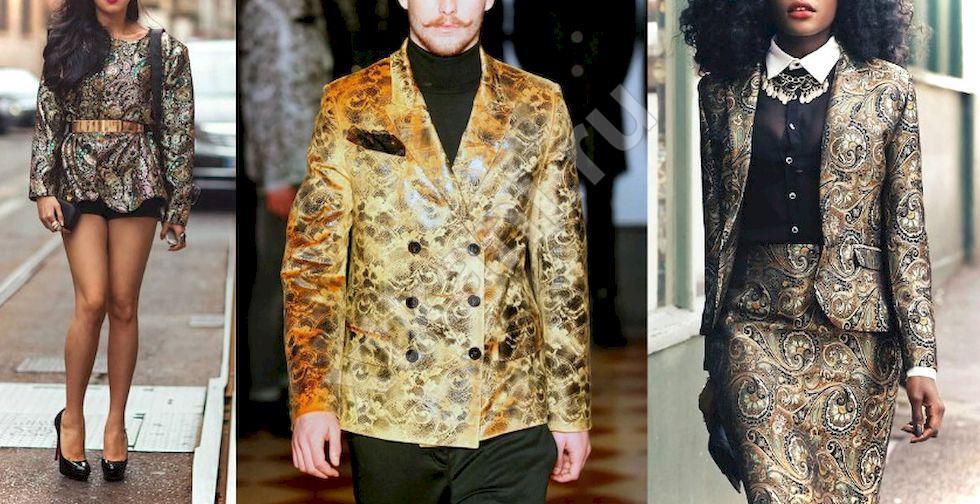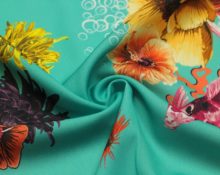One of the symbols of luxury and wealth, an attribute of the nobility and kings for many centuries, is brocade fabric. Its massiveness and sophisticated appearance create a monumental impression. The history of this material goes back several thousand years, during which brocade has not lost its relevance and relevance.
History of appearance
This material was first created in Ancient China, where silk fabric was used to make clothes for the emperor., began to decorate with woven threads of gold and silver. Manual work on it took a long time and required special skill. Later, along the Great Silk Road through Central Asia, the fabric came to Persia and other states of the Middle East.
Interesting! The word “brocade” itself came into Russian from Persian. Translated it means “matter”.
Following the samples came the art of its manufacture. The further route of brocade to Europe ran through Byzantium.In the Middle Ages, it became a favorite material for the robes of royalty and their entourage. Further it has always been considered an item of special luxury, and it began to be used in the production of everyday clothing only in the middle of the 20th century.

Production Features
Currently, this fabric is produced industrially in many countries around the world. Production volumes made it possible to significantly reduce the price of brocade. In the same time in Asian countries, primarily China and India, it is still made by hand. Products made from brocade made in this way are an expensive and valuable gift with a touch of local flavor.
The type of fabric made in China is called “Nanjing” or “Sichuan”. This city in the east of the country has long been one of the centers of textile production. Its second name is “cloudy" This brocade is very soft to the touch and stands out for its unusual patterns. It is also divided into several varieties:
- patterned;
- satin;
- gold;
- Kujin.
The first of them is made only by hand, and the production technology is included in the list of objects of the intangible cultural heritage of humanity.
Traditional Indian brocade is Yamdani. This is a silk fabric with the addition of gold and silver threads. The material is made exclusively by hand and is used to sew suits for special occasions.
Interesting! In the Celestial Empire, there is a concept of “three levels of perfection of Chinese brocade.” It includes the three most famous types of unique fabric, which are called “songjin”, “shujin” and “yunjin”. They are produced using ancient technologies in the cities of Suzhou and Nanjing and Sichuan province.
Artificial brocade is made using other, cheaper materials. Viscose fibers are used instead of silk, and silver and gold are replaced by Lurex - a synthetic thread coated with foil of different colors.

What does brocade look like?
Items made from it are almost impossible to confuse with items made from other fabrics. Its appearance is distinguished by grace, richness and unusual design. Silk or its substitutes, which create the basis of brocade, shimmer very beautifully from different angles.
Appearance of the material
Brocade fabric differs in heavy weight, which is due to the presence of metal threads in its composition. They create original patterns that create a unique look for the fabric. At first glance, you get a feeling of luxury, of touching something royal. Brocade colors are deep and rich. The most common ones are gold, red, blue and green.
Composition, properties
Classic brocade consists of two main components: silk fabric and threads made of precious metals, gold and silver. The pattern can be embroidered or produced on a jacquard loom. It has the most sophisticated appearance, is dense and easily draped.
From the point of view of consumer properties, viscose brocade is almost no different from it. In its composition silk is replaced with viscose fabric, and instead of gold and silver threads, the pattern is made of lurex. Synthetic fabric is much cheaper than its progenitor.
The basis of lycra brocade is elastane - synthetic material based on rubber. It is less rigid, has better stretch and has the same attractive appearance as natural material.
All types of material have common properties - these are heavy weight, high resistance to creasing, characteristic large pattern on shiny fabric. The fabric has good thermoregulation ability.

Benefits of Brocade
- Due to the presence of metal threads in the fabric, it differs special strength. The fabric is wear-resistant and this makes it an excellent material for upholstery of furniture subject to significant loads.
- These same threads give her a very spectacular appearance, which none of the other types of fabrics have.
- The fabric is almost does not wrinkle, allows air to pass through wellwithout causing discomfort when wearing things made from it.
- The material is very dense and holds its shape perfectly. This allows you to avoid using linings from other fabrics when sewing dresses and other items of clothing.
- Brocade is wonderful drapes, and its folds shimmer beautifully in the light.
- The fabric can also combine with any other materials, which makes it a favorite of many fashion designers.
Flaws
The advantages of brocade also have a downside:
- Metal threads tarnish and lose their appearance over time when exposed to air, moisture and ultraviolet radiation.
- Mechanical damage is also possible, which practically cannot be corrected.
- Fabrics containing artificial metal threads are somewhat less susceptible to this problem.
- The material is very demanding to care for, which makes it almost inapplicable in everyday life.
- In addition, even artificial brocade made using lycra or viscose has a very high price.

What kind of fabric is brocade embroidered with gold? What is the name of?
Particularly striking is the brocade fabric, the pattern on which is embroidered with gold threads. She called by the Turkish word "altabas" and was popular at the imperial court in Byzantium. Clothing was made from it, which was a distinctive symbol of the top government. From there the material came to Russia, where it quickly began to enjoy success with the Tsar and his entourage.
The fabric also came into use among the clergy - they began to sew church robes from it and use it to decorate churches. In the 18th century, wearing clothes made from it was strictly regulated by a special decree of Peter I.
Types of fabric
The textile industry produces several main types of material:
- classic, with a base made of silk fabric;
- viscose, based on synthetic fibers;
- lycra, which contains elastane, which gives the material greater softness.
In addition to them, there are less common types of fabric, which include: wool or cotton fibers. Such additives are used to give the material hygienic and heat-insulating properties.
Clothing and interior items made of brocade
The unique appearance of the fabric and its features make brocade not very convenient for making items for daily use. Most often the material goes for the production of curtains and curtains, as well as upholstery of expensive furniture. A similar interior can be seen in various institutions or in expensive rooms of the best hotels in the world. Products made from brocade perfectly emphasize wealth and status and give the premises a truly royal look.
Now she is in demand for creating various theatrical props. Brocade costumes and dresses are an integral part of any historical film or performance. In some countries where fabric has been produced for many centuries, clothing and brocade are a mandatory attribute of special events.
Brocade is traditionally used in India for sewing wedding dresses. It is often used to sew costumes worn by movie stars on the red carpet. Also this is the main material for sewing priestly robes.
To make items for everyday wear, cheap brocade based on viscose or cotton is used. You can find it on sale trousers, dresses and jackets from her. Lycra fabric, which stretches more easily, is often used to make summer clothes, as well as costumes used in figure skating and rhythmic gymnastics.
Ideal materials to combine with brocade are velvet and lace.. Fabrics of different textures complement each other, giving the products an unusual and luxurious look. They are also often used in the manufacture of curtains. veil and organza, softening the heaviness of brocade. In general, you should approach wearing such clothes thoroughly, since in some cases they can look more vulgar than beautiful.

The nuances of caring for things
The subtleties of proper storage and care of brocade products are determined by its complex composition - silk fibers and metal threads have different requirements.
Important! Traditionally, recommendations for washing and ironing clothes are given on factory labels.
- The shine of metallized threads can fade even at high temperatures due to the influence of chemicals contained in laundry detergents.
- If the item is of particular value, then the best option would be the services of special ateliers engaged in dry cleaning.
- At home, brocade items can only be washed by hand, using delicate detergents and without the use of bleach.
- Drying should occur naturally, without contact with heat sources.
- If it is necessary to press seams, then this should be done from the wrong side of the garment.


 0
0





